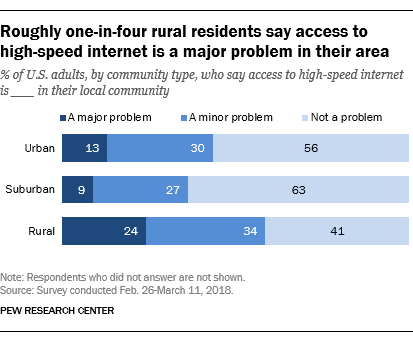Many of us long to get offline, even out of range, for a day or so. We are constantly connected to our devices and welcome those mini-vacations where we can unplug.
Yet our perfect vacation is a daily reality for an astonishing number of Americans who lack the high-speed access we take for granted. According to Pew Research Center, roughly one in four rural residents has no access to high-speed internet and 42% lack access at home.

“When I’ve heard numbers like these, I always assumed ‘rural’ meant small, isolated pockets out in the wide-open spaces of the West or tucked into the hollows of Appalachia where the population density and topography made it difficult to support high-speed infrastructure,” writes Heidi Tolliver-Walker in Printing News. “It never occurred to me that it meant entire cities and regions we would never imagine.”
Tolliver-Walker refers to a CNN broadcast on the topic that stunned her.
“Correspondent Miguel Marquez interviewed residents of Cleveland, Tenn., a community of 44,000 outside Chattanooga, where there is no broadband access,” she writes. “Chattanooga has some of the fastest internet in the country, yet Cleveland—just 34 miles away—has no broadband access at all.”
The FCC is spending billions to increase broadband access yet, as Tolliver-Walker explains, there are still “millions of businesses and residents without access to any but the most basic internet services. Sure, there are mobile hotspots, but not everyone can afford them.”
Let’s set aside for a moment what this means for people who live in those areas – (education, resources, job opportunities, etc.) – and consider what it means for businesses. For a national brand, 8% of their potential audience has no high-speed internet.
“Local marketers have learned who cannot be reached with digital channels, but national marketers may not be as tuned in to where their graphics-heavy emails and social media and digital advertising efforts may not be reaching,” Tolliver-Walker writes. “In cities like Cleveland, businesses and residents may be completely blind to the digital components of your campaigns.”
Completely blind to your digital marketing efforts – no social media ads, no landing pages, no email campaigns – that’s a sobering thought. And it reinforces the importance of direct mail and other print materials.
“The challenges to bringing broadband to nearly 8% of the U.S. population are great, and they aren’t likely to be solved any time soon,” Tolliver-Walker continues. “Until then, print and other traditional channels remain critical to reaching these customers, whether business or consumer. So before your clients cut their print budgets in favor of digital marketing, make sure they don’t need those 8% of the U.S. population that they may not be able to reach.”
Why print? In a surprising number of cases, because it’s that or nothing.
